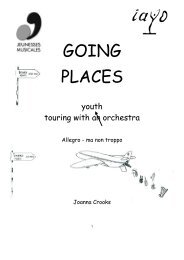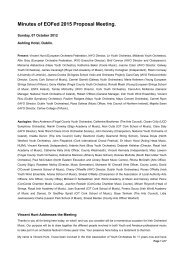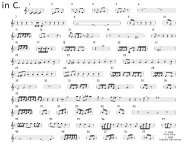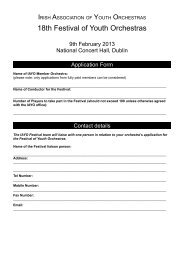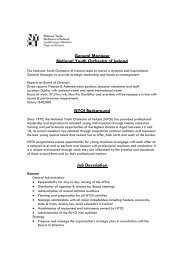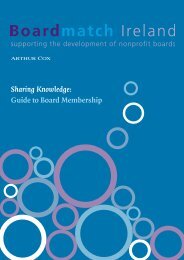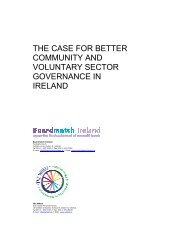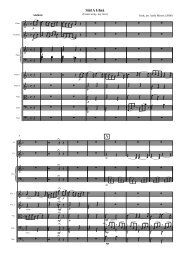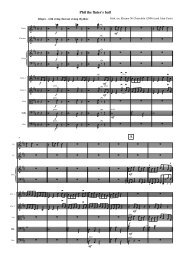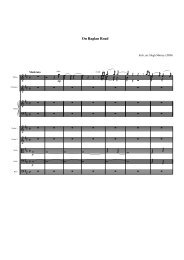A SOUND EAR II - Association of British Orchestras
A SOUND EAR II - Association of British Orchestras
A SOUND EAR II - Association of British Orchestras
Create successful ePaper yourself
Turn your PDF publications into a flip-book with our unique Google optimized e-Paper software.
A <strong>SOUND</strong> <strong>EAR</strong> <strong>II</strong><br />
whole orchestra. It might be reasonable to have some sympathy with this view; after all, the noise team idea was just<br />
a suggested way <strong>of</strong> giving responsibility for monitoring noise to a specific group <strong>of</strong> people, who were willing to accept<br />
further training as and when it became available, and were willing to embrace a code <strong>of</strong> practice which they could<br />
insist was followed. It was intended as a way to get management, musicians and music directors, collectively, to take the<br />
matter seriously. If individual orchestras have found a better way for themselves they should be encouraged.<br />
Where noise teams have been active it would seem that the elected representatives for H&S have not always been<br />
included within the group. H&S elected representatives should always be involved in all matters which<br />
affect the wellbeing <strong>of</strong> the musicians, as should those who are responsible for making risk assessments.<br />
TOP TEN TIPS<br />
1 Get your heads together! Management and players should pool ideas and take joint responsibility. It sounds<br />
obvious, but discussion about the music should come first, as it is the source <strong>of</strong> the noise.<br />
2 Always assess the risks and record them with recommendations.<br />
3 Have courage to take action to provide protection when it is needed. Do not wait and see! Musicians get<br />
angry if they think managers have not thought about the problem.<br />
4 Always have a supply <strong>of</strong> various ear defenders available even if you have provided individual custom-made<br />
plugs for your players. You need to protect your extras as well!<br />
5 Make sure you carry enough screens, shields and absorbent materials to all venues and be proactive in<br />
placing them in appropriate positions.<br />
6 If possible carry individual risers and general rostra with you to give flexibility <strong>of</strong> seating.*<br />
7 Negotiate better acoustic controls, and build a dialogue, with your regular venues.<br />
8 Agree a safe seating plan well in advance and discuss this with the conductor (who should be allowed a view<br />
but not have a veto!)<br />
9 Integrate noise management into a general policy <strong>of</strong> health screening and pr<strong>of</strong>iling – this way it makes more<br />
sense and changes attitudes.<br />
10 Be open to all new initiatives from the commercial sector even if you have to reject the ideas and equipment<br />
after fair trial.<br />
*It will cause many orchestras, especially the smaller ones, some financial hardship if carrying extra equipment<br />
means hiring or purchasing a larger van. It may be possible to persuade venues, over time, to provide what<br />
is needed and to keep it on site. As the message begins to sink in, many venue managements will feel some<br />
responsibility to contribute to the noise management policy <strong>of</strong> regular clients and partners.<br />
35<br />
CONCLUSIONS<br />
There is no doubt that the pr<strong>of</strong>ession, if not yet up to the mark, is rising to it very rapidly. In addition to the orchestras<br />
visited there are many others, and this is clear from applications to the Healthy Orchestra Charter, which are actively<br />
making changes, experimenting with seating, providing audiometric testing and ear plug advice, supplying earplugs<br />
and investing in screens and acoustic panels, and organising their own training with expert contributors. Others have<br />
applied for ABO training and a new round has just begun. Any who are still unsure where to begin, and there cannot<br />
be many, should contact the ABO immediately as there is now much expert advice available within and without the<br />
business. Remember that the law applies from April 2008 – there are no exclusions and no exemptions.<br />
Malcolm Warne Holland<br />
Director, MWH ASSOCIATES - Orchestra Management Consultants.<br />
November 2007



